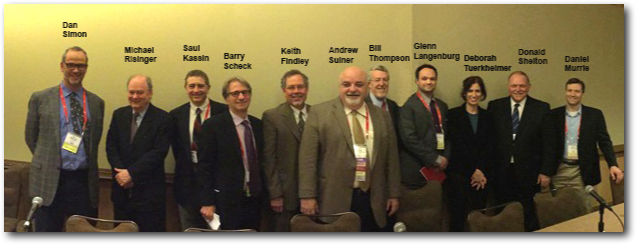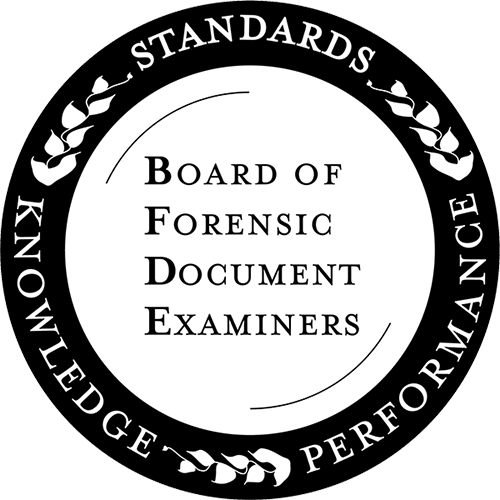Board of Forensic Document Examiners
COGNITIVE BIAS in FORENSICS
On February 17, Andrew Sulner and Barry Scheck presented a full-day workshop on Cognitive Bias that attracted over 100 paid attendees for the second year in a row. The workshop, entitled “Cognitive Bias Issues in the Forensic Analysis of Pattern and Impression Evidence and in Medico-legal Evaluations,” comprised a multidisciplinary faculty of distinguished professionals drawn from the fields of psychology, law, medicine, and forensic science. This is a synopsis of the presentations
On February 17, Andrew Sulner and Barry Scheck presented a full-day workshop on Cognitive Bias that attracted over 100 paid attendees for the second year in a row. The workshop, entitled “Cognitive Bias Issues in the Forensic Analysis of Pattern and Impression Evidence and in Medico-legal Evaluations,” comprised a multidisciplinary faculty of distinguished professionals drawn from the fields of psychology, law, medicine, and forensic science. This is a synopsis of the presentations
The workshop began with a brief commentary by AAFS President Daniel A. Martell, a forensic neuropsychologist, who stressed the importance of the information to be presented about the impact of cognitive bias on forensic casework. Dr. Martell emphasized that although cognitive bias clearly exists, it is not an issue of examiner ethics or personal character; it is simply part of the way the human brain operates, and something that can be mitigated and minimized once properly identified and studied.

Seton Hall University Law School Professor Michael Risinger outlined the history of the study of cognitive bias in general and its relationship to the forensic sciences. Professor Risinger discussed various strategies for mitigating the potential adverse effects of cognitive bias, including case management techniques such as sequential unmasking, a two-stage process in which the filtration of domain-irrelevant information is coupled with the sequential release of domain-relevant information in order to reduce the potential for bias to influence the outcome of an analyst’s evaluation of evidence.
Workshop Chair Andrew Sulner, a third generation board certified forensic document examiner, used actual case histories to illustrate ways in which cognitive bias can improperly sway and taint the decision-making and testimony of handwriting experts. Mr. Sulner also discussed de-biasing techniques, one being the Fischhof Method of Upside-down Comparison developed by his grandfather, Professor Julius Fischhof, a pioneer in the field of questioned documents and Eastern Europe’s leading handwriting expert in the 19th century. Fischhof recognized that in the context of text-based handwriting, the familiarity of letters or words can unconsciously contribute to the failure on the part of an examiner to observe salient writing features, most notably differences between two sets of text-based signatures or handwritten items that appear to be very similar. He discovered that by comparing such questioned and known signatures or handwriting upside down, the examiner is not subconsciously influenced by reading individual letters or words and has a more objective view of writing features. The Fischhof Method is an effective tool that handwriting experts can employ to counter potential observer effects of contextual bias related to the familiar constructs of letters or words.
Hon. Donald E. Shelton, a retired trial judge and current Director of the University of Michigan Criminal Justice Program, discussed judicial bias as it relates to the role of gatekeepers in controlling for potential bias on the part of experts in civil and criminal cases as well as biases they might not recognize in themselves. Judge Shelton spoke about “Dissonance Theory,” which addresses one’s natural tendency to try to view any new discomforting information in a way that aligns it with more comforting preconceptions.
Dan Simon, USC Law School Professor of Law and Psychology, discussed cognitive and motivational causes of investigative error in general and in relation to the criminal justice system. Professor Simon discussed and illustrated the various mechanisms of “selective” reasoning that can bias a criminal or forensic investigation and cause errors that result in miscarriages of justice. He began his presentation by providing the audience with a series of visual tasks and exercises that convincingly demonstrated their susceptibility to bias (observer effects) and unconscious judgment errors. He then explained the dynamic and complex nature of criminal and forensic investigations and how bias can result in improperly structuring an investigation, misinterpreting evidence, and inducing misleading and inaccurate testimony. Finally, he discussed recommendations for controlling or minimizing the influence of cognitive and motivational biases.
Saul Kassin, John Jay College Professor of Psychology, discussed the overwhelming impact of confessions and presented several cases in which false confessions led to wrongful convictions despite other evidence being inconclusive or even exculpatory. The biasing power of a confession, even when false, is so overwhelming that it is difficult to overcome. The case histories presented by Dr. Kassin were very troubling because they destroyed the preconceived belief of most workshop attendees that innocent people would never voluntarily confess to a crime they didn’t commit. Dr Kassin effectively demonstrated how interrogation techniques can lead innocent people to perceive that confessing to a crime is somehow in their best interests, and how a false confession can bias and improperly influence the analysis and interpretation of other evidence in the case, thereby facilitating a wrongful conviction.
The afternoon session began with Daniel C. Murrie, a forensic psychologist, discussing recent research addressing cognitive bias in forensic evaluations and psychological assessments, and explaining the concept of “allegiance,” which is the tendency for forensic evaluators to make evaluations that favor the retaining party. Dr. Murrie reviewed the findings of a study of “allegiance” that was conducted by the Institute of Law, Psychiatry and Public Policy at the School of Medicine and University of Virginia School of Law, and he suggested various methods for mitigating allegiance effects.
Glenn M. Langenburg, a forensic scientist with expertise in friction-ridge-print analysis, spoke about the impact of two sources of contextual bias—exposure to case information and interaction with investigators—on the identification decisions of certified latent print examiners. Reviewing data from his own research to indicate that errors from bias effects were much more pronounced when the examinations were deemed “difficult” or “complex” and/or dealt with “exclusion” decisions, Dr. Langenburg suggested that until research studies demonstrate that applying sequential unmasking or blind verification procedures to all cases will reduce the number of errors in casework or be cost effective and worth the resources dedicated to instituting such procedures, it makes more sense from a resource standpoint to use such masking procedures only in the small subset of cases where the effect of bias is most likely to have an impact.
UC Irvine Professor William C. Thompson, who is both an attorney and a psychologist, presented the next topic, “Contextual Bias and Domain-Relevance: Lessons from Weapons of Mass Destruction (WMD) Forensics.” Dr. Thompson explained that bias occurs when an analyst’s judgement is influenced by information that is irrelevant to the task, and that susceptibility to bias is not a character flaw, but a human condition that affects everyone. He explained why practitioners within each forensic discipline need to establish clear-cut standards defining the information that is relevant to each task they perform before determining the optimal timing for the sequential unmasking of such information to an analyst. Dr. Thompson discussed various proposed solutions for controlling bias, such as the Case Manager Model, Sequential Unmasking, and Blind Reviews.
Following the afternoon break, the workshop’s presentations focused on cognitive bias issues in evaluating Shaken Baby Syndrome/Abusive Heat Trauma (SBS/AHT). Northwestern University Law School Professor Deborah Tuerkheimer explained that when it comes to the triad of symptoms that physicians have historically relied upon to support a diagnosis of SBS/AHT — subdural hematoma, retinal hemorrhages and cerebral edema (brain swelling) — clinical medical practice has lagged behind research that has established other causes of the triad. Professor Tuerkheimer explained that despite research studies revealing non-abusive origins of the triad, incorrect medical beliefs of the triad’s diagnostic significance still persist within the medical profession. She described cases in which false assumptions, even in the face of contradictory medical evidence, led to miscarriages of justice, including one in which the true facts came to light only after a blind review of the entire medical file was conducted.
Dr. Lucy Roarke-Adams, a pediatric and forensic neuropathologist, explained how history and physical and radiographic findings can properly support a diagnosis of SBS/AHT if the expert deciding whether or not abuse occurred has extensive training and experience in both pediatrics and the subspecialty of child abuse. Dr. Rorke-Adams discussed how the intersection of law and medicine in an adversarial criminal justice system creates tension between attorneys and physicians due to differences in their educational background, training and experience.
Wisconsin University Law School Professor Keith A. Findley’s topic, “A Critical Look at Cognitive Bias Issues in Expert Testimony About Non-accidental Head Injury,” used case histories and examples of expert testimony by pediatricians to demonstrate how role effects and conformity pressures can influence decisions in child abuse cases. Professor Findley discussed and illustrated the impact of context biases and confirmation biases on the diagnosis of child abuse and the necessity of using blind testing and sequential unmasking protocols to overcome bias.
The final speaker of this intense day was workshop co-Chair Barry Scheck, co-director of The Innocence Project and one of America’s most well-known and respected criminal defense attorneys. Mr. Scheck reviewed the medical and non-medical evidence presented in several criminal cases, including that of Louise Woodward (the “British Nanny” case), to illustrate the ways in which cognitive bias can affect clinical observations and evaluations upon which decisions are based as to whether infant brain injuries should be attributed to abuse or accident. He discussed recent research studies in the fields of medicine and biomechanics which demonstrate that other diseases or conditions can mimic the symptoms typically associated with SBS/AHT, and he urged the medical and legal communities to engage in meaningful dialogue with a view towards improving the assessment of pediatric head trauma by implementing practical procedures and protocols to minimize and control the effects of potentially biasing influences.
After the last presentation, all workshop speakers and attendees participated in a Q&A Panel which proved to be very lively. Audience comments on the workshop were very favorable, and attendees received a 580-page workshop handbook containing each speaker’s selected reference material.
